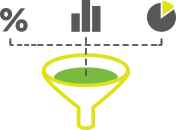Our comprehensive, four-step approach is the most effective path to obtaining optimal results when the time comes to generate and distribute the dashboards. Moreover, our experienced coaches can bring even more expertise and proficiency to the project.
However, companies who, for various reasons, do not wish to carry out steps 1 and 2: qualification and selection of metrics, can still quickly produce effective dashboards using the integrated knowledge database, which contains a number of predetermined metrics in various fields. It is always possible to add other metrics or adjust the existing ones over time. Our principle is simple: DESIGN ONCE, GENERATE FOREVER!
SecureEcom experts have established a proven, four-step approach that ensures that the company’s managers have all the right information at hand, presented clearly and simply. Our approach is distinct, progressive and intuitive.
Work session to qualify the metrics
Who does what, when, why and for whom? It is important that metrics qualify according to the organization’s priorities, critical assets and types of projects. Quality should be favoured over quantity. Which metrics reveal the most pertinent information according to the objectives to be achieved? We opt for meaningful rather than plentiful metrics.
Work session to choose the metrics
This phase serves to identify the metrics (KPIs) that will tell us the most when the time comes to take action or to assess the severity of a risk related to cybersecurity and business risk. Indicators that are important to operations are not necessarily useful for a vice-president or for a business line. The look, relevance and performance of the dashboard all depend on this judicious selection of metrics.
Creation of metrics (KPIs) and dashboard
INDIK includes an exceptional knowledge database containing multiple categories of metrics and dashboard templates by field of activity. It is therefore possible to create and generate metrics using these predefined categories. With INDIK, setting up the dashboard requires minimum effort and one-time design. In other words, the design is done once, but up-to-date content and real-time data can be generated again and again, without having to return to the initial design stage.
Approval and implementation
The fourth step consists in an automated workflow to validate the data. It is the application that takes the information provided and sends it to the target community according to the approval process set up by the organization. Users therefore receive instructions, reminders and alerts, from the moment the data is entered up to the final approval of the dashboards.




